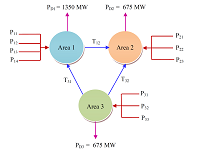Robust Multi-Area Economic Dispatch Using Coulomb’s and Franklin’s Laws Based Optimizer
DOI:
https://doi.org/10.46604/ijeti.2020.5447Keywords:
CFLBO, metaheuristic approach, multi-area economic load dispatch, multi-fuel alternativesAbstract
The multi-area economic load dispatch (MAELD) can reduce running costs through making the areas with more cost-effective units produce more energy. The excess power is transferred to the areas with expensive units. This paper contributes a new physics inspired metaheuristic approach called the Coulomb’s and Franklin’s laws based optimizer (CFLBO) to solve the MAELD problem. The CFLBO approach is developed from Coulomb’s and Franklin’s theories, which comprise attraction/repulsion, probabilistic ionization, and contact stages. The effectiveness of the envisaged CFLBO approach has been examined on three standard test systems with various areas. Results obtained by the CFLBO approach are compared with the exchange market algorithm (EMA) and the existing state-of-the-art approaches to deal with MAELD. Numerical outcomes show the benefits of the quick convergence and better quality of the suggested approach compared to existing strategies. Consequently, the proposed approach is a helpful tool for generation planning in MAELD problems.
References
R. R. Shoults, S. K. Chang, S. Helmick, and W. M. Grady, “A practical approach to unit commitment, economic dispatch and savings allocation for multiple-area pool operation with import/export constraints,” IEEE Transactions on Power Apparatus and Systems, vol. PAS-99, no. 2, pp. 625-635, March 1980.
V. H. Quintana, R. Lopez, R. Romano, and V. Valadez, “Constrained economic dispatch of multi-area systems using the dantzig-wolfe decomposition principle,” IEEE Transactions on Power Apparatus andSystems, vol. PAS-100, no. 4, pp. 2127- 2137, April 1981.
Z. Ouyang and S. M. Shahidehpour, “Heuristic multi-area unit commitment with economic dispatch,” IEEProceedings C - Generation, Transmission and Distribution,vol. 138, no. 3, pp. 242-252, May 1991.
C. Wang and S. M. Shahidehpour, “A decomposition approach to nonlinear multi-area generation scheduling with tie-line constraints using expert systems,” IEEE Transactions on Power Systems, vol. 7, no. 4, pp. 1409-1418, November 1992.
D. Streiffert, “Multi-area economic dispatch with tie line constraints,” IEEE Transactions on Power Systems, vol. 10, no. 4, pp. 1946-1951, November 1995.
T. Yalcinoz and M. J. Short, “Neural networks approach for solving economic dispatch problem with transmission capacity constraints,” IEEE Transactions on Power Systems, vol. 13, no. 2, pp.307-313, May 1998.
Y. Z. Li, L. Jiang, Q. H. Wu, P. Wang, and H. B. Gooi, “Wind-thermal power system dispatch using MLSAD model and GSOICLW algorithm,” Knowledge Based Systems, vol. 116, pp. 94-101, January 2017.
T. Jayabarathi, G. Sadasivam, and V. Ramachandran, “Evolutionary programming based multi-area economic dispatch with tie line constraints,” Electric Machines and Power Systems, vol. 28, no. 12, pp. 1165-1176, November 2000.
P. S. Manoharan, P. S. Kannan, S. Baskar, and M. Iruthayarajan, “Evolutionary algorithm solution and KKT based optimality verification to multi-area economic dispatch,” International Journal of Electrical Power and Energy Systems, vol. 31, no. 7-8, pp. 365-373, September 2009.
M. Sharma, P. Manjaree, and S. Laxmi. “Reserve constrained multi-area economic dispatch employing differential evolution with time varying mutation,”International Journal of Electrical Power and EnergySystems, vol. 33, no. 3, pp. 753-766, March 2011.
P. Somasundaram and N. M. Jothi Swaroopan, “Fuzzified particle swarm optimization algorithm for multi-area security constrained economic dispatch,” Electric Power Components and Systems, vol. 39, no. 10, pp. 979-990, June 2011.
M. Basu, “Artificial bee colony optimization for multi-area economic dispatch,”International Journal of Electrical Power and Energy Systems, vol. 49, no. 7, pp. 181-187, July 2013.
M. Basu, “Teaching-learning-based optimization algorithm for multi-area economic dispatch,” Energy, vol. 68, no. 4, pp. 21-28, April 2014.
M. Basu, “Fast convergence evolutionary programming for multi-area economic dispatch,” Electric Power Components and Systems, vol. 45, no. 15, pp. 1629-1637, December 2017.
M. Ghasemi, S. Ghavidel, J. Aghaei, E. Akbari, and L. Li, “CFA optimizer: A new and powerful algorithm inspired by Franklin’s and Coulomb’s laws theory for solving the economic load dispatch problems,” International Transactions on Electric Energy Systems,vol. 28, no. 5, e2536, May 2018.
T. T. Nguyen, “A high performance social spider optimization algorithm for optimal power flow solution with single objective optimization,” Energy, vol. 171, no. 3, pp. 218-240, March 2019.
A. Sundaram, “Combined heat and power economic emission dispatch using hybrid NSGA II-MOPSO algorithm incorporating an effective constraint handling mechanism,” IEEE Access, vol. 8, pp. 13748-13768, January 2020.

Published
How to Cite
Issue
Section
License
Copyright Notice
Submission of a manuscript implies: that the work described has not been published before that it is not under consideration for publication elsewhere; that if and when the manuscript is accepted for publication. Authors can retain copyright in their articles with no restrictions. Also, author can post the final, peer-reviewed manuscript version (postprint) to any repository or website.

Since Jan. 01, 2019, IJETI will publish new articles with Creative Commons Attribution Non-Commercial License, under Creative Commons Attribution Non-Commercial 4.0 International (CC BY-NC 4.0) License.
The Creative Commons Attribution Non-Commercial (CC-BY-NC) License permits use, distribution and reproduction in any medium, provided the original work is properly cited and is not used for commercial purposes.







.jpg)


